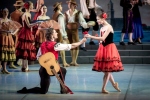The red capes of the toreadors, the strumming of guitars, the clicking of castanets, coquettish glances
from behind open fans… The enchanting levity of the ‘ballet of Spain’ will surge onto the Segerstrom Hall
stage. Each role demands virtuosity and stamina as the dancers interpret this ballet in their own individual
ways.
It is possible to depict the sincerity and straightforwardness of the characters or present them as
cunning deceivers; place an emphasis on simple domestic details or portray fiery passions. The
permutations are endless, and therein lies one of the secrets of the ballet’s phenomenal popularity and
why each performance holds surprises and becomes an ‘event’ unto its own.

Don Quixote is one of the most life-affirming, colorful and festive ballets. It’s interesting that, despite its
name, this brilliant piece is not a stage version of the famous novel by Miguel de Cervantes, but an
original choreographic work by Marius Petipa vaguely based on Don Quixote. The music was written by
composer Ludwig Minkus, at that time a professor of the Moscow Conservatory. On 14 December 1869,
the Moscow Bolshoi Theatre gave a première of the comic play staged by Marius Petipa, telling a story of
the failed wedding of a young beauty and a rich nobleman, because of the true love of the heroine for a
poor fellow.

The story was popular with other choreographers before Petipa: Franz Hilverding (Vienna, 1740) and
Louis Milon (Paris, 1801). Charles Didelot, Filippo Taglioni, and August Bournonville were also among
those, who developed the theme. In 1871, Petipa created a new version of the ballet for the première at
the Bolshoi Kamenny Theatre in St. Petersburg.
In 1900, on the initiative of director of the Moscow Office of the Imperial Theatres Vladimir Telyakovsky, a new production of Don Quixote was carried out by Alexander Gorsky (1871 – 1924). Gorsky kept the scenario plan and, partly, Petipa’s choreography. The
Spanish dance by Anton Simon and Fandango by Eduard Napravnik were added to Minkus’s music.
Gorsky organized the crowd scenes in a new way to avoid “any symmetry”.
Borrowing from the principles of theatrical aesthetics of the Moscow Art Theatre, Gorsky did much for the “revival” of academic ballet.
On 20 January 1902, the Gorsky production with scenery by Konstantin Korovin, Alexander Golovin, and
Nikolay Klodt, was shown at the Mariinsky Theatre. The stars of the imperial stage, as Mathilde
Kschessinska (Kitri), Nicholas Legat (Basilio), Enrico Cecchetti (Sancho Panza), Alexey Bulgakov (Don
Quixote), Olga Preobrazhenskaya (Street Dancer) contributed to the success of this remarkable
performance. The production became the classical one. At the Mikhailovsky Theatre the ballet Don
Quixote has been revised by Mikhail Messerer: he used much of what had been suggested by several
generations of choreographers, including students and followers of Alexander Gorsky. The best ballet
soloists are happy to share with the audience the joy they feel performing the ballet that never fades.
About the Artists
Anastasia Soboleva studied at the Kiev State Ballet School. In 2010, she graduated from the Moscow
State Ballet Academy. In 2007, as a student, she participated in Bolshoi’s tour to London with Class
Concert (choreography by Asaf Messerer). As a senior student, she danced Lise in La Fille mal gardée
(production by Yury Grigorovich). As a graduate, she joined the Bolshoi Ballet. For three years with the
Bolshoi Ballet, she danced the whole classical repertoire, participated in premières of new productions
and performed leading roles. In 2013, she joined the Mikhailovsky Ballet as a ballet soloist, where she
has danced principal and solo roles in Swan Lake, Le Corsaire, Giselle, ou Les Wilis, Don Quixote, La
Bayadère, Laurencia, La fille mal gardée, The Flames of Paris, Class Concert, Cipollino, The Sleeping
Beauty, The Nutcracker. At the galas, she also danced Melody by Messerer and duet from The Lady and
the Hooligan (chor. by K. Boyarsky).
Angelina Vorontsova was born in Voronezh and studied at the Voronezh State Ballet School. In 2008,
she entered the Moscow State Ballet Academy. In 2009, she graduated from the Moscow Ballet Academy
and joined the Bolshoi Ballet Company. She rehearsed with Nikolay Tsiskaridze, who also was her first
partner in the performances at the Bolshoi Theatre. She made her debut at the Bolshoi Theatre in the
premiere of the ballet The Curse of the House of Usher choreographed by Vladimir Vasiliev in the
framework of the Russian National Orchestra Festival under the baton of Mikhail Pletnev. In 2013, she
joined the Mikhailovsky Ballet, where her repertoire includes principal roles in Giselle, ou Les Wilis, Swan
Lake, La Bayadère, Don Quixote, Le Corsaire, The Flames of Paris, Laurencia, The Nutcracker, The
Sleeping Beauty, Romeo, and Juliet, Prelude, La Fille mal gardée, White Darkness, Le Halte de cavalerie,
Mikhailovsky Ballet & Orchestra
Victor Lebedev was born in St. Petersburg and graduated from the Vaganova Ballet Academy in 2010
and the same year joined the Mikhailovsky Ballet. As a student, he was a recipient of the scholarship from
the Farukh Ruzimatov Foundation. He has been recognized for his artistic excellence at the international
ballet competitions in Krasnoyarsk and St. Petersburg. At the Mikhailovsky Theatre his repertoire includes
principal roles in Le Corsaire, Swan Lake, Giselle, La Fille mal gardée, La Sylphide, La Bayadère, Don
Quixote, Cipol,lino, The Flames of Paris, Class Concert and the productions by Nacho Duato The
Sleeping Beauty, The Nutcracker, Without Words, Duende, Prelude and Multiplicity, Forms of Silence and
Emptiness.
Ivan Vasiliev was born in Vladivostok. He studied at the Dnepropetrovsk Ballet School in Ukraine and
later at the Belarus State Ballet School in Minsk, graduating in 2006. While still a student, Vasiliev danced
Basilio in Don Quixote and Ali in Le Corsaire with the Belarus National Ballet. In 2006, he was invited to
join the Bolshoi Ballet as a Soloist, making his debut with the Company, at the age of 17, as Basilio in
Don Quixote. He was promoted to Principal Dancer in 2010. In 2011, he joined the Mikhailovsky Ballet as
a Principal Dancer. Vasiliev’s repertoire with the Mikhailovsky includes principal roles in Don Quixote,
Giselle, The Sleeping Beauty, Romeo and Juliet, La Fille mal gardée, La Bayadère, Laurencia, La
Sylphide, The Flames of Paris, Le Halte de cavalerie and Class Concert. His awards include medals at
the international ballet competitions in Varna, Moscow, and Perm. He is also the winner of the Triumph
Youth Prize, British Critics’ Circle National Dance Awards in the category Spotlight and as Best Male
Dancer, and the Benois de la Danse Award for his performance in Le Corsaire and The Flames of Paris
(2009). In 2011, he received Grand Prix at the International Dance Open Festival. In 2014, he was
awarded the title of Honored Artist of Russia.
In 2012–2013, Ivan Vasiliev was a Principal Dancer with American Ballet Theatre (ABT). In 2014, he took
part in the closing ceremony of the Winter Olympics in Sochi (Natasha Rostova’s First Ball scene). In
2015, Ivan Vasiliev made his debut as a choreographer: at the Barvikha Luxury Village he premiered his
Ballet № 1. In 2016, he staged three one-act ballets — Morphine, Blind Affair, and Bolero — which are
included in the repertoire of the Mikhailovsky Theatre. In May 2016, Vasiliev’s ballet Love is All Around
premiered at the Bolshoi Theatre in Moscow.
Segerstrom Center for the Arts is an acclaimed arts institution as well as a beautiful multi-disciplinary
cultural campus. It is committed to supporting artistic excellence, offering unsurpassed experiences and
to engaging the entire community in new and exciting ways through the unique power of live performance
and a diverse array of inspiring arts-based education and community engagement programs.
Segerstrom Center for the Arts is also proud to serve as the artistic home to three of the region’s major
performing arts organizations: Pacific Symphony, Philharmonic Society of Orange County and
Pacific Chorale, who contribute greatly to the artistic life of the region with annual seasons performed at
Segerstrom Center for the Arts.
Photos By Jack Devant
scfta.org


















